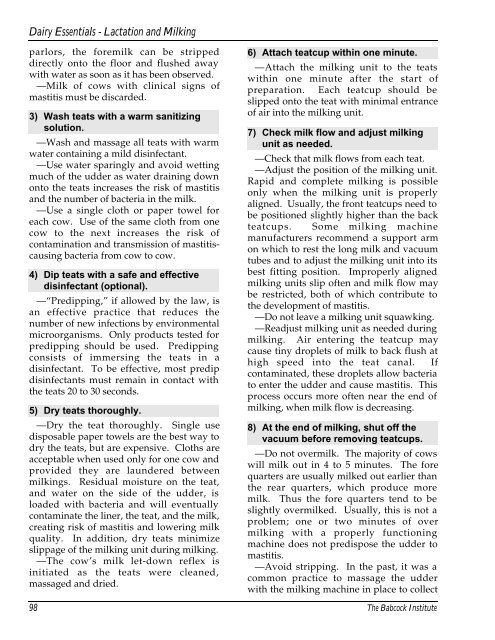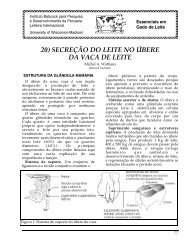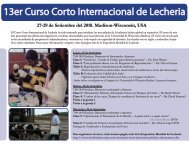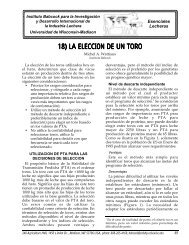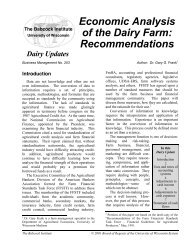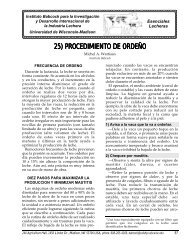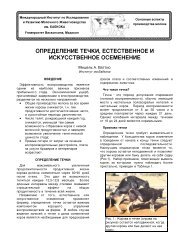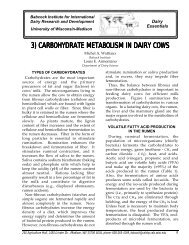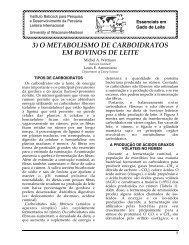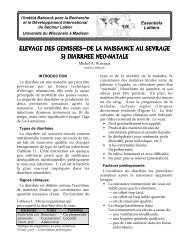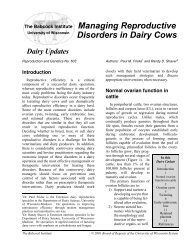25) milking procedure - Babcock Institute - University of Wisconsin ...
25) milking procedure - Babcock Institute - University of Wisconsin ...
25) milking procedure - Babcock Institute - University of Wisconsin ...
You also want an ePaper? Increase the reach of your titles
YUMPU automatically turns print PDFs into web optimized ePapers that Google loves.
Dairy Essentials - Lactation and Milkingparlors, the foremilk can be strippeddirectly onto the floor and flushed awaywith water as soon as it has been observed.—Milk <strong>of</strong> cows with clinical signs <strong>of</strong>mastitis must be discarded.3) Wash teats with a warm sanitizingsolution.—Wash and massage all teats with warmwater containing a mild disinfectant.—Use water sparingly and avoid wettingmuch <strong>of</strong> the udder as water draining downonto the teats increases the risk <strong>of</strong> mastitisand the number <strong>of</strong> bacteria in the milk.—Use a single cloth or paper towel foreach cow. Use <strong>of</strong> the same cloth from onecow to the next increases the risk <strong>of</strong>contamination and transmission <strong>of</strong> mastitiscausingbacteria from cow to cow.4) Dip teats with a safe and effectivedisinfectant (optional).—“Predipping,” if allowed by the law, isan effective practice that reduces thenumber <strong>of</strong> new infections by environmentalmicroorganisms. Only products tested forpredipping should be used. Predippingconsists <strong>of</strong> immersing the teats in adisinfectant. To be effective, most predipdisinfectants must remain in contact withthe teats 20 to 30 seconds.5) Dry teats thoroughly.—Dry the teat thoroughly. Single usedisposable paper towels are the best way todry the teats, but are expensive. Cloths areacceptable when used only for one cow andprovided they are laundered between<strong>milking</strong>s. Residual moisture on the teat,and water on the side <strong>of</strong> the udder, isloaded with bacteria and will eventuallycontaminate the liner, the teat, and the milk,creating risk <strong>of</strong> mastitis and lowering milkquality. In addition, dry teats minimizeslippage <strong>of</strong> the <strong>milking</strong> unit during <strong>milking</strong>.—The cow’s milk let-down reflex isinitiated as the teats were cleaned,massaged and dried.6) Attach teatcup within one minute.—Attach the <strong>milking</strong> unit to the teatswithin one minute after the start <strong>of</strong>preparation. Each teatcup should beslipped onto the teat with minimal entrance<strong>of</strong> air into the <strong>milking</strong> unit.7) Check milk flow and adjust <strong>milking</strong>unit as needed.—Check that milk flows from each teat.—Adjust the position <strong>of</strong> the <strong>milking</strong> unit.Rapid and complete <strong>milking</strong> is possibleonly when the <strong>milking</strong> unit is properlyaligned. Usually, the front teatcups need tobe positioned slightly higher than the backteatcups. Some <strong>milking</strong> machinemanufacturers recommend a support armon which to rest the long milk and vacuumtubes and to adjust the <strong>milking</strong> unit into itsbest fitting position. Improperly aligned<strong>milking</strong> units slip <strong>of</strong>ten and milk flow maybe restricted, both <strong>of</strong> which contribute tothe development <strong>of</strong> mastitis.—Do not leave a <strong>milking</strong> unit squawking.—Readjust <strong>milking</strong> unit as needed during<strong>milking</strong>. Air entering the teatcup maycause tiny droplets <strong>of</strong> milk to back flush athigh speed into the teat canal. Ifcontaminated, these droplets allow bacteriato enter the udder and cause mastitis. Thisprocess occurs more <strong>of</strong>ten near the end <strong>of</strong><strong>milking</strong>, when milk flow is decreasing.8) At the end <strong>of</strong> <strong>milking</strong>, shut <strong>of</strong>f thevacuum before removing teatcups.—Do not overmilk. The majority <strong>of</strong> cowswill milk out in 4 to 5 minutes. The forequarters are usually milked out earlier thanthe rear quarters, which produce moremilk. Thus the fore quarters tend to beslightly overmilked. Usually, this is not aproblem; one or two minutes <strong>of</strong> over<strong>milking</strong> with a properly functioningmachine does not predispose the udder tomastitis.—Avoid stripping. In the past, it was acommon practice to massage the udderwith the <strong>milking</strong> machine in place to collect98 The <strong>Babcock</strong> <strong>Institute</strong>


